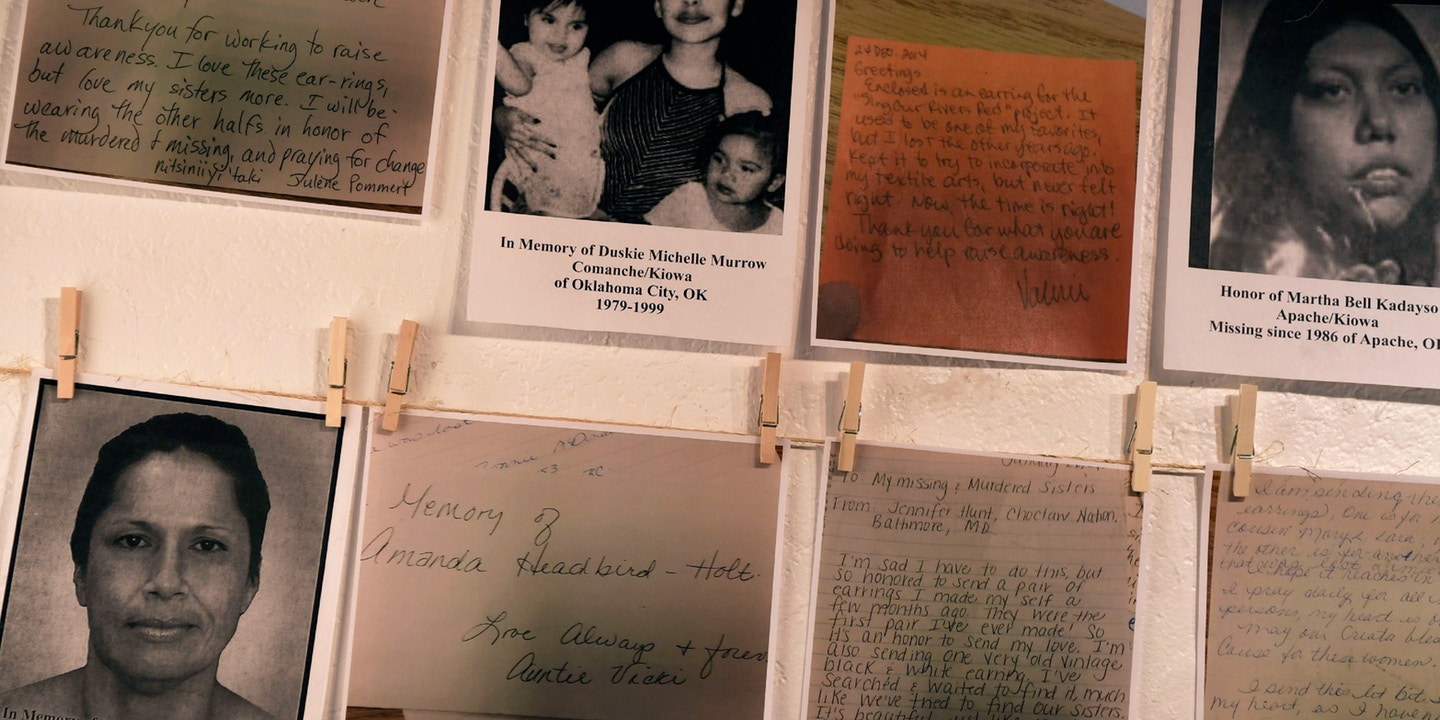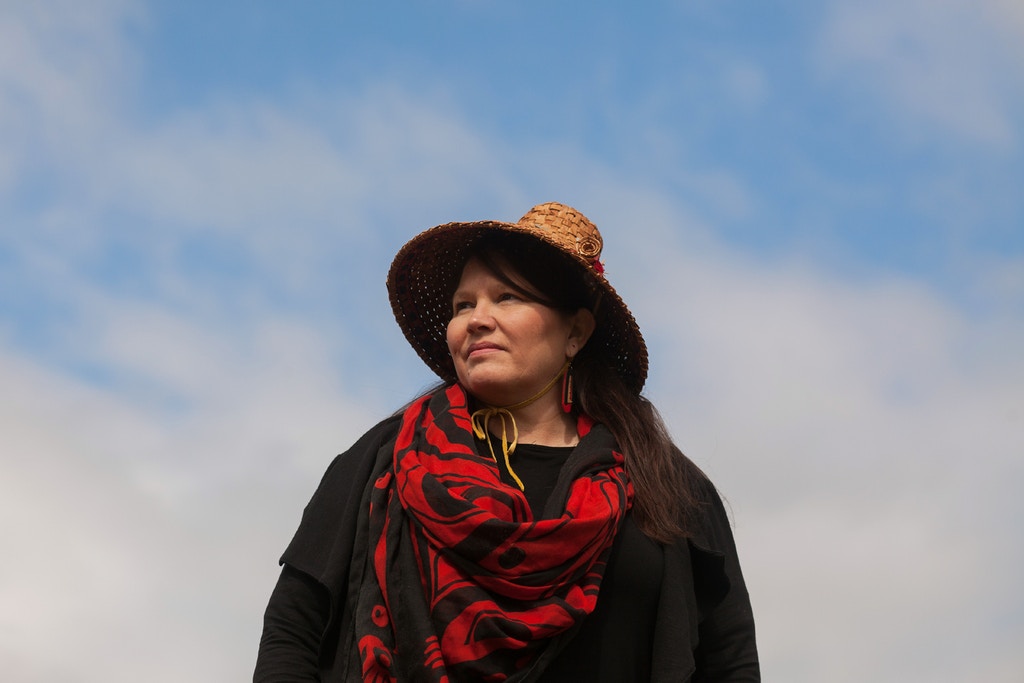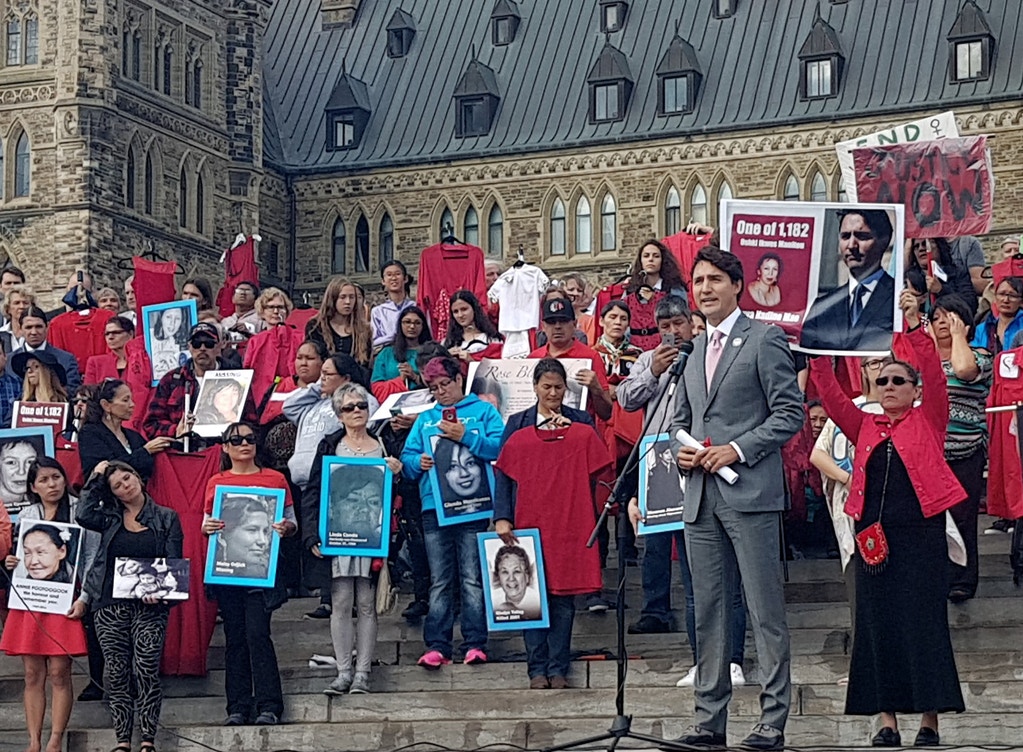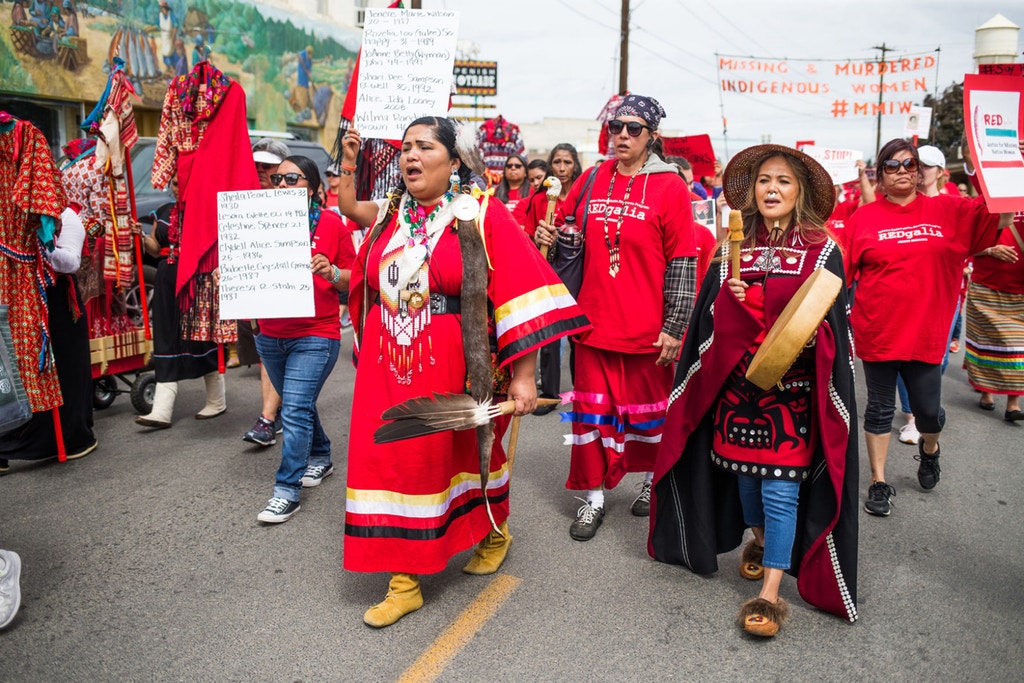Indigenous women have been disappearing for generations. Politicians are finally starting to notice.
Brown, The Intercept, May 31 2018, 9:31 p.m.
the Yakama Indian Reservation in Washington state didn’t have any particular
term for the way the violent deaths and sudden disappearances of their sisters,
mothers, friends, and neighbors had become woven into everyday life.
 |
|
Photo:
Denver Post via Getty Images |
“I didn’t
know, like many, that there was a title, that there was a word for it,” said
Roxanne White, who is Yakama and Nez Perce and grew up on the reservation.
White has become a leader in the movement to address the disproportionate rates
of homicide and missing persons cases among American Indian women, but the
first time she heard the term “missing and murdered Indigenous women” was less
than two years ago, at a Dakota Access pipeline resistance camp at Standing
Rock. There, she met women who had traveled from Canada to speak about
disappearances in First Nations to the north, where Prime Minister Justin
Trudeau’s administration launched a historic national inquiry into the issue in
2016.
exactly what they were talking about,” White said. “I had survived all of this
and witnessed all of this.” White’s aunt was murdered in 1996, and there were
plenty of others in her orbit who had disappeared or died violently.
mid-2000s, the FBI re-examined 16 deaths in the vicinity of the Yakama
reservation, mostly Native American women whose remains were found between 1980
and 1992 — so many deaths in such quick succession that many were convinced it
must have been the work of a serial killer. As the mysterious deaths went
unsolved, community members also became convinced
of the FBI’s indifference.
the agency released
its findings; investigators had discovered no serial killer or any one culprit.
Ten of the deaths were believed by the FBI to be homicides — women who had been
shot, stabbed, beaten, or run over. Two of the deaths were classified as
accidental drownings, one woman died of hypothermia, and in three cases, the
cause of death was unknown. Media attention moved on after the anticlimactic
results, although women on the reservation continued
to disappear
and die under suspicious circumstances.
years later, a new law
set to take effect in June will require the Washington State Patrol to
determine just how many American Indian women have gone missing in the state.
Working with tribes and the Department of Justice, the agency will use the data
as part of a study to determine how to report and identify missing women.
sponsor was state Republican Rep. Gina Mosbrucker, whose district includes
Yakama — Mosbrucker is a fifth-generation resident of Klickitat County, which
includes the southern edge of the reservation. But Mosbrucker was compelled to
act on the issue of missing and murdered Indigenous women not in the wake of
the murders on the reservation near her home, but after seeing the 2017 film “Wind River,” a fictional
account of the murder of a young woman found frozen in the snow on a
reservation in Wyoming. “The more I looked into it, and the more I spoke to
tribal members living in Washington, I realized this isn’t just some Hollywood
storyline,” Mosbrucker said.
a little bit of justice in the acknowledgement that there’s an injustice,” said
Carolyn DeFord, whose mother, Leona LeClair Kinsey, a member of the Puyallup
Tribe, disappeared 18 years ago. “It’s a slow boat to turn around, because it’s
a 500-year-old problem.”
first time, the U.S. government is taking steps toward addressing a problem
that until recently went unnamed. The Washington law is among a handful of
recent legislative efforts, including proposed legislation in Minnesota and a
federal bill known as Savanna’s Act, that seek to ramp up data collection
around missing Indigenous persons and improve protocols for investigations of
crimes on reservation land.
Canada provides any clues, the road ahead will be steep for organizers and
families who are pushing for an end to the violence and neglect. There, many
families have rescinded their support for the inquiry launched by Trudeau,
arguing that it has been mismanaged and re-traumatizing for families and has
followed a colonial model that excludes the grassroots.
argue that any chances of success lie in the government’s willingness to follow
the lead of communities most impacted. As Annita Lucchesi, a Southern Cheyenne
cartographer who is building a database of missing and murdered Indigenous
women, put it, “I don’t think you can fix problems that have been created by
poor legislation with more legislation rooted in the same way of knowing and in
the same culture.”
 |
|
Two red
dresses hang in a tree at Swan Creek Park on May 11, 2018, in Tacoma, Wash. The red dresses symbolize missing and murdered Indigenous women.
Photo:
Jovelle Tamayo for The Intercept |
Data
Reveals Indifference
database includes cases in the U.S. and Canada going back to 1900, relying on
news reports, law enforcement data, government missing persons databases, and
information shared by Indigenous families and community members. So far, her
data set includes 2,501 cases, and
it’s far from complete.
the vanishing women is an array of causes — domestic violence and sex
trafficking, as well as police indifference, racism, lack of resources
allocated to tribal governments, and complex jurisdictional issues between
tribal, federal, and local law enforcement that slow down investigations in
their crucial first days and make it easier for non-Indigenous people to get
away with violent crime. For most criminal cases, tribal courts lack the
ability to prosecute perpetrators who are not tribal members. Although the 2013
Violence Against Women Reauthorization Act allowed tribal courts to pursue
domestic violence cases committed by non-Native people, not all tribes exercise
that jurisdiction, and many other types of physical and sexual violence are not
covered by the exception.
is building her database because no government entity has undertaken such an
effort. As demonstrated in an investigative
series by Reveal, data collection on missing persons is terrible in
the U.S. — the central repository for information, the National Missing and
Unidentified Persons System, or NamUs, contains data that’s submitted only
voluntarily by law enforcement and is thus incomplete. When it comes to
Indigenous women, the problem is exacerbated by confusing jurisdictional issues
on reservation land, where it’s often unclear which agencies have
responsibility to look for a missing person or submit their information to the
database.
about those who have been murdered is also sparse — it’s been less than a
priority for U.S. police to track homicide rates of Indigenous women, if the
convoluted responses to Lucchesi’s requests for historical data are any
indication.
data that does exist provides a window into the scope of the violence and its
impact on Indigenous women’s lives. According to the results of the 2010
National Intimate Partner and Sexual Violence Survey, 84 percent of Indigenous
women interviewed had experienced violence in their life; 56 percent had
experienced sexual violence. According to data collected between 1992 and
2001, American Indians were twice
as likely as any other racial group to be raped or sexually assaulted. A study
of American Indian causes of death between 1999 and 2009 found Indigenous women
had a homicide rate three times that of white women. And an analysis
of data collected between 1994 and 1998 showed that some counties had murder
rates of American Indian women that were more than 10 times the national
average. Much of this data is limited by the willingness of individuals to
report violence to police and of law enforcement to designate deaths as
homicide.
the data is a key objective of the proposed laws. The most significant piece of
legislation so far is Savanna’s Act,
introduced in October 2017 by U.S. Sen. Heidi Heitkamp, a Democrat from North
Dakota. The act is named for Savanna LaFontaine-Greywind, a 22-year-old member
of the Spirit Lake tribe who was eight months pregnant when she disappeared
from her home in Fargo in August 2017. Her body was found a week later in the
Red River. She had been murdered
by neighbors who kidnapped her newborn.
would see tribal affiliation added to federal databases, including NamUS; the
National Crime Information Center (the FBI’s primary data collection system);
and other databases that aggregate fingerprints and DNA. It would force the
U.S. attorney general to develop a plan for making those databases more
accessible to tribal governments and require the Department of Justice to
develop a standard protocol for investigating cases of missing and murdered
Indigenous people. The government would also be required to submit an annual
report with statistics about missing and murdered Indigenous women and
recommendations for improving the data. Heitkamp is currently working on
building support for the bill.
floor of the U.S. Senate, Heidi Heitkamp, D-N.D., shares stories of missing and
murdered Indigenous women, on Oct. 5, 2017.
federal legislation would provide grants
for victims services in tribal communities, collect
better data on American Indian human trafficking victims, and improve
access to the AMBER alert system in Indian country.
Minnesota, legislation
to create a task force on missing and murdered Indigenous women was introduced
on March 1. The bill asks the task force to uncover the “underlying historical,
social, economic, institutional, and cultural factors” behind the violence
and provide recommendations on how to better track missing Indigenous women,
prevent violence against them, and support healing from trauma.
legislation was pushed
forward by two Indigenous lawmakers. One of them, state Rep. Jamie Becker-Finn,
who grew up on the Leech Lake Reservation, has described
how her great-grandmother disappeared back in 1931. Although her body was later
discovered, how she died has never been determined.
 |
|
Carolyn
DeFord in Tacoma, Wash., on May 11, 2018. DeFord’s mother, Leona LeClair Kinsey, a member of the Puyallup Tribe, disappeared 18 years ago.
Photo:
Jovelle Tamayo for The Intercept |
Everybody
Knows Somebody
mother disappeared, Carolyn DeFord, who was raising her three young children
paycheck to paycheck at the time, found a void of support and information. Her
mom lived in the small town of La Grande, Oregon, and had struggled with
addiction for a couple of years. DeFord felt that police didn’t move quickly to
find her because they knew her history. DeFord recalled an officer with the La
Grande Police Department reminding her that it was not illegal for an adult to
disappear — it was implied that her mother might be out partying. But DeFord
knew her mother would never have left her beloved dog locked in the house;
something severe had happened. Nearly two decades later, DeFord’s mother has
not reappeared.
went on, DeFord began reaching out to other women whose family members had gone
missing. She manages a Facebook page
that features photos of missing persons and the details of their cases. When
she travels, she brings a stack of posters “of somebody who’s in my mind that
day. I don’t necessarily pick or choose. Whoever I’m feeling, I put out there,”
she said. The stories she’s heard from others are familiar: investigations
delayed because of assumptions about the lifestyle of the missing person — or
about Indigenous people more broadly; lack of clarity around which agency
should be searching; little support for families grappling with trauma; and an
overwhelming sense of erasure.
 |
| Carolyn DeFord holds a photo of herself, right, with her mother, Leona LeClair Kinsey, on May 11, 2018, in Tacoma, Wash. The photo was taken at Kinsey’s home in La Grande, Ore., when DeFord was 19 years old. Photo: Jovelle Tamayo for The Intercept |
The
growing movement around missing and murdered Indigenous women didn’t arise out
of data — it came from the fact that so many Indigenous women know someone who
has died violently or disappeared. One of the hallmarks of the movement is that
it does not center around how the woman was murdered or who killed her. It
identifies the generations-long elimination of thousands of women from
Indigenous communities as a direct result of government attempts to eliminate
Indigenous cultures.
legislative efforts at addressing the complex matrix of issues behind the
violence only begin to acknowledge that long history. Already, Lucchesi and
other advocates say the new legislation in Washington overlooks some of the
root causes of the unsolved disappearances. In particular, Lucchesi points to
the fact that it is the Washington State Patrol that will conduct the state’s
study.
probably not the best agency to do it,” she said. “That’s already a fraught
relationship there.” The Yakama Nation Tribal Council, for example, recently
passed a resolution
declaring a public safety crisis on the reservation, noting that the crisis can
be traced in part to the state patrol’s “refusal to actively patrol”
Washington’s public rights of way that fall within reservation boundaries.
an unfortunate replication of the [Canadian] inquiry — to rely on Western legal
framework,” said Lucchesi. “There’s quite a few families who don’t feel
comfortable talking to law enforcement, that would feel more comfortable coming
forward and sharing these stories if it was someone from their own community.”
 |
| Maggie Cywink, right, holds up a sign behind Canadian Prime Minister Justin Trudeau as he speaks during a vigil in support of missing and murdered Indigenous women in Ottawa on Oct. 4, 2017. Photo: Courtesy of Maggie Cywink |
Canada’s
Inquiry Leaves Families Disillusioned
Maggie Cywink was grappling with the 1994 murder of her sister Sonya Nadine,
women were only beginning to hold marches in Canada to draw attention to their
disappeared friends and relatives.
shared her story with Amnesty International, which published a groundbreaking report
in 2004, titled “Stolen Sisters: A Human Rights Response to Discrimination and
Violence Against Indigenous Women in Canada.” Three years later, serial killer
Robert Pickton was sentenced to life imprisonment after the remains of 33 women
— including a number of Indigenous women and sex workers — were found on his
pig farm. An inquiry
carried out between 2010 and 2012 found that because of who the women were,
“police investigations into the missing and murdered women were blatant
failures.” Meanwhile, organizing around the issue was intensifying — the
Indigenous Idle No More movement made
missing and murdered Indigenous women a central issue in its high-profile
actions that began in 2012.
only continued to build. In 2014, the Royal Canadian Mounted Police released
its estimate
of Canada’s missing and murdered Indigenous women: 1,181 between 1980 and 2012,
which some have argued is a significant undercount.
Then, in 2015, Canada’s Truth and
Reconciliation Commission released its findings. The commission was
the result of a class-action lawsuit brought by survivors of Canada’s
residential schools, which were rife with abuse and served as a key part of the
country’s assimilation attempts, tearing children from their families and
cultures. One of the commission’s recommendations was that a missing and
murdered Indigenous women inquiry should be launched.
 |
|
Maggie
Cywink, right, with her sisters Anastasia, left, and Sonya, center, ice fishing in 1972. Photo: Courtesy of Maggie Cywink |
“Then the
Liberal government made the national inquiry a campaign promise,” said Cywink.
“It went from something that was personal, that was grassroots, that was
family, to something that became a political thing.”
minister, Trudeau has promised a “total renewal”
of relations with Indigenous Canadians and announced the launch of the National Inquiry into Missing and Murdered Indigenous
Women and Girls, which also includes transgender, two-spirit, and
nonbinary people as part of its mandate.
felt a sense of relief. We all felt a sense of validation, that thank god this
government is actually paying attention — helping us carry this burden we’ve
been carrying all these generations. Maybe a little bit of our guard was let
down,” said Sheila North Wilson, grand chief of Manitoba’s Keewatinowi
Okimakanak organization.
families and advocates quickly became disillusioned, as commissioners were
chosen with little input from longtime organizers. “We are deeply concerned and
confused as to why so many of the most renowned family leaders, advocates,
activists, and grassroots (in short, those known and respected across the
country with a deep subject matter expertise), have not been asked to help,”
wrote Cywink and more than 50 other advocates and family members in a letter
to Chief Commissioner Marion Buller in May 2017.
afterward, a commissioner and multiple staffers quit — the inquiry seemed to be
in disarray. In another
letter addressed to Trudeau, more than 140 signatories called for a
“hard reset” of the inquiry, including the replacement of Buller, a member of
the Mistawasis First Nation and British Columbia’s first Indigenous Provincial
Court judge, who was described in the letter as sidelining family members
rather than including their voices as central to the process.
inquiry continued, with commissioners touring the nation, offering families
space to publicly share their missing or murdered relatives’ stories. Cywink
was disturbed by the lack of trauma care offered by the commission, and she
didn’t think it was clear what the stories would even be used for. She decided
not to submit the story of her sister.
commissioners finished their tour last month, they requested an additional two
years to complete their ambitious goal: to build a foundation from which
Indigenous women could reclaim their power and place and ultimately end cycles
of violence rooted in Canada’s foundations as a nation. Some critics
of the inquiry, such as the Native Women’s Association of Canada, have come out
in support
of an extension (which so far has not been granted).
Cywink and other organizers felt that the commission’s time was up. “You’ve had
testimony from over 1,000 people. That should be plenty,” Cywink explained in
an interview with The Intercept. “Write your report and be done with it. Then
we’ll take all the recommendations that you give us, plus the thousands that
we’ve already got, and we’ll ask the government for more money, then we’ll
start to implement them.”
national inquiry has bulldozed through our communities and with an extension
will continue to exacerbate the emotional and psychological burden on the very
people it is intended to solace,” Cywink, North Wilson, and around 200 families
and leaders wrote in another letter
on April 11. “A recurring narrative from communities has emerged: They came,
they took stories, they left.”
between the inquiry’s dysfunction and government inaction, Canadians remain
immobilized voyeurs and consumers of horrific stories of missing and murdered
Indigenous women, girls, trans and two spirit people.”
decades, the signatories were ready to be done proving the issue exists.
 |
|
Roxanne
White, center, leads a march through downtown Toppenish, Wash., wearing red to bring awareness to missing and murdered Indigenous women on May 5, 2018. Photo: |
to Be the Ones to Demand Justice”
Takes War Bonnet, a public education specialist for the Native Women’s Society
of the Great Plains, pointed out that what happened in Canada is unlikely to
happen the same way in the U.S. — at least not anytime soon. She works in South
Dakota, where legislators passed a law
in 2010 meant to prevent Native communities from holding the churches that ran
American Indian boarding schools accountable for sexual assault.
in a country where so little has been done to account for 500 years of
colonization and genocide, she takes heart from legislative efforts by
politicians like Heitkamp — even if they’ve missed some of the root causes of
the issue. She acknowledged that Heitkamp’s support for the oil industry in
some ways conflicts with her work on human trafficking and missing and murdered
Indigenous women. (The Trudeau administration, too, has been blasted by leaders
of Canadian First Nations for agreeing this week to purchase the highly
controversial Trans Mountain Pipeline for $4.5 billion, after pipeline owner
Kinder Morgan threatened to drop the project. Several First Nations have been
fighting in court to stop the project and leaders have called
the purchase a betrayal of the reconciliation process.)
played a key role
in ending the crude oil export ban, opening up the Bakken oil region to new
markets overseas. On Heitkamp’s press
releases about Savanna’s Law, she noted her previous efforts to
address violence against Indigenous women, including pushing for the opening of
an FBI field office on tribal land after the oil boom brought
an influx of drugs, sex trafficking, and other crime.
politician, so you’ve got to ride the fence, and you’ve got to do both things,”
said Takes War Bonnet. She feels the federal legislation is a crucial first
step for the U.S. government. “It’s really important work that she’s doing,
because it helps set precedent.”
communities across the U.S. held gatherings in acknowledgement of a newly
designated National Day of Awareness for Missing and Murdered Native Women and
Girls. Roxanne White led a march of tribal members dressed in red through the
Yakama reservation town of Toppenish, Washington. She asked marchers for the
names of women and men who were gone. “I had so many people telling me this
name, this name, all at once,” White said. White estimates she called out 30
names.
the only ones that are going to speak for them. It’s not going to be the
president or the governor,” White said. “We have to be the ones to come out and
demand justice, demand the police, when somebody goes missing, to do their damn
job, hold them accountable.”


